Unit 2 I'd like some noodles 复习课件(共22张PPT)2023-2024学年鲁教版五四学制七年级英语上册
文档属性
| 名称 | Unit 2 I'd like some noodles 复习课件(共22张PPT)2023-2024学年鲁教版五四学制七年级英语上册 |
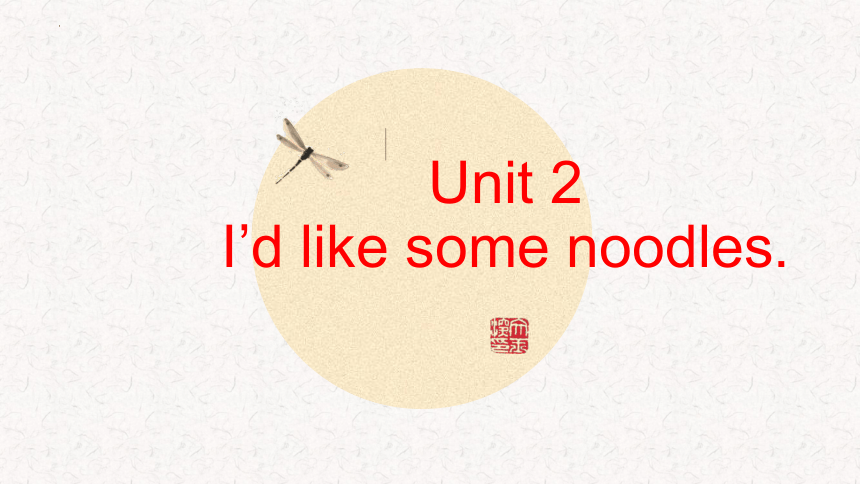
|
|
| 格式 | pptx | ||
| 文件大小 | 431.2KB | ||
| 资源类型 | 教案 | ||
| 版本资源 | 鲁教版 | ||
| 科目 | 英语 | ||
| 更新时间 | 2023-10-10 20:17:00 | ||
图片预览

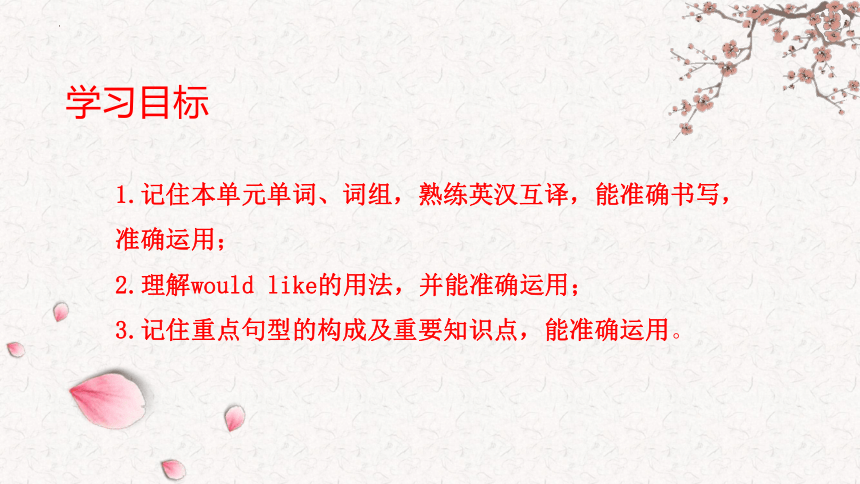
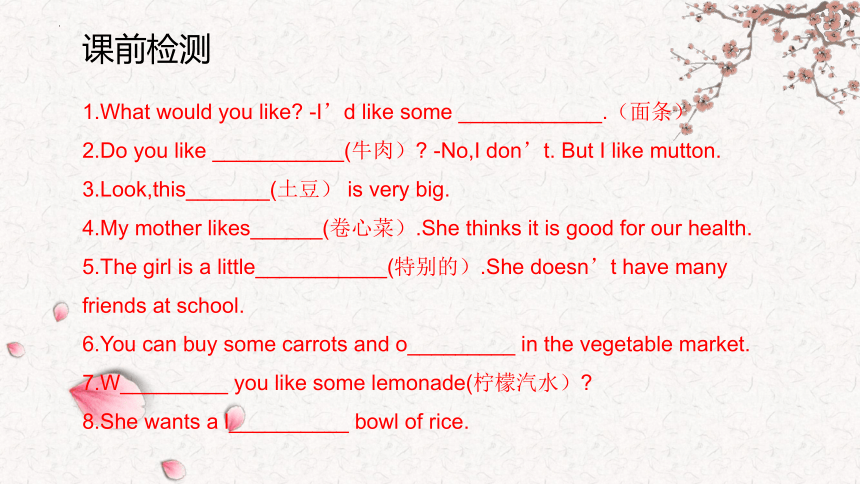
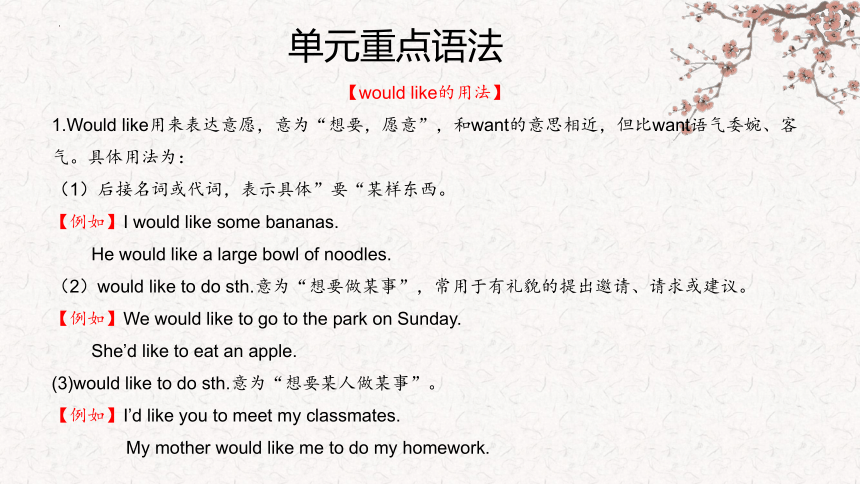
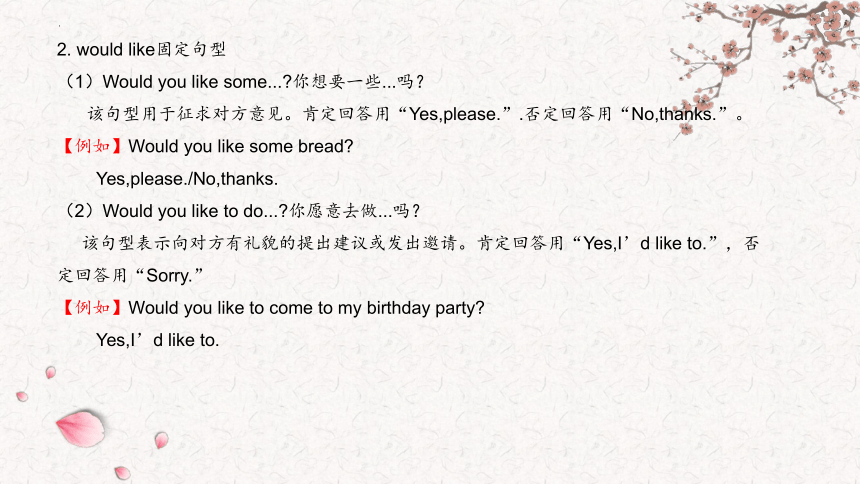

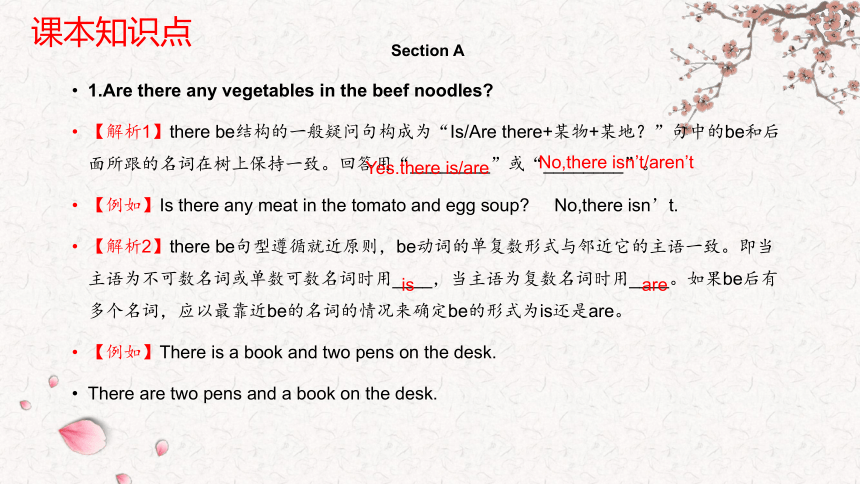
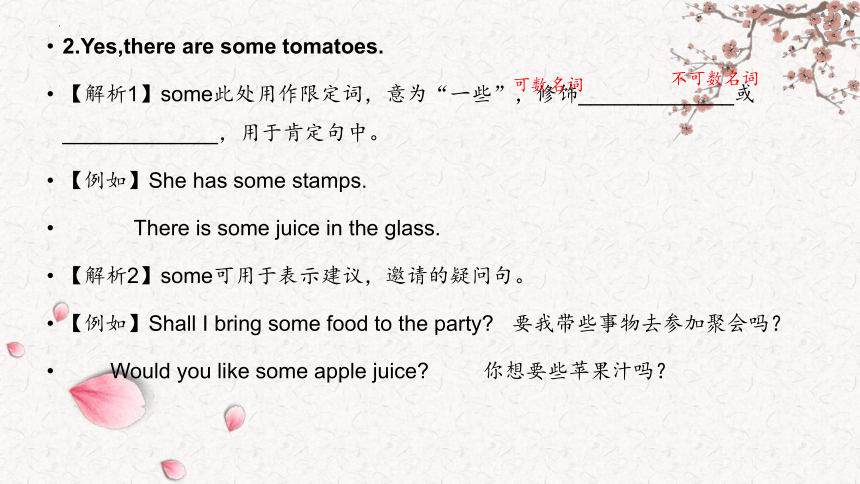
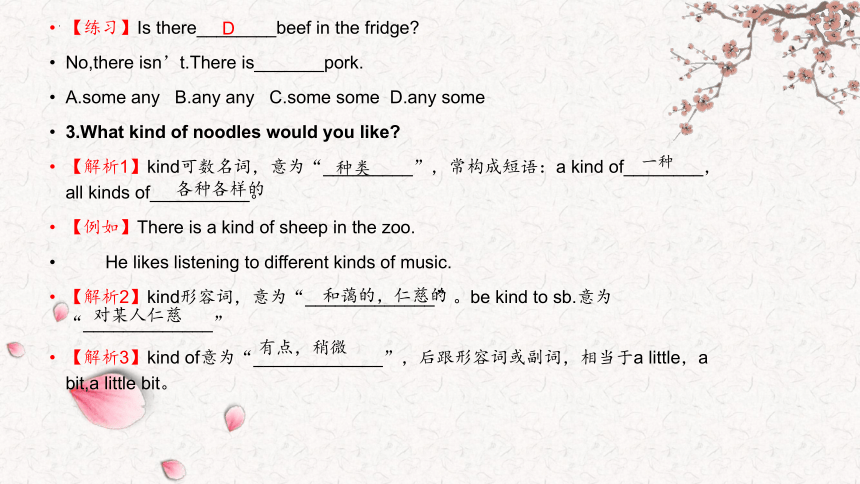
文档简介
(共22张PPT)
Unit 2
I’d like some noodles.
1.记住本单元单词、词组,熟练英汉互译,能准确书写,准确运用;
2.理解would like的用法,并能准确运用;
3.记住重点句型的构成及重要知识点,能准确运用。
学习目标
1.What would you like -I’d like some ____________.(面条)
2.Do you like ___________(牛肉) -No,I don’t. But I like mutton.
3.Look,this_______(土豆) is very big.
4.My mother likes______(卷心菜).She thinks it is good for our health.
5.The girl is a little___________(特别的).She doesn’t have many friends at school.
6.You can buy some carrots and o_________ in the vegetable market.
7.W_________ you like some lemonade(柠檬汽水)
8.She wants a l__________ bowl of rice.
课前检测
【would like的用法】
1.Would like用来表达意愿,意为“想要,愿意”,和want的意思相近,但比want语气委婉、客气。具体用法为:
(1)后接名词或代词,表示具体”要“某样东西。
【例如】I would like some bananas.
He would like a large bowl of noodles.
(2)would like to do sth.意为“想要做某事”,常用于有礼貌的提出邀请、请求或建议。
【例如】We would like to go to the park on Sunday.
She’d like to eat an apple.
(3)would like to do sth.意为“想要某人做某事”。
【例如】I’d like you to meet my classmates.
My mother would like me to do my homework.
单元重点语法
2. would like固定句型
(1)Would you like some... 你想要一些...吗?
该句型用于征求对方意见。肯定回答用“Yes,please.”.否定回答用“No,thanks.”。
【例如】Would you like some bread
Yes,please./No,thanks.
(2)Would you like to do... 你愿意去做...吗?
该句型表示向对方有礼貌的提出建议或发出邀请。肯定回答用“Yes,I’d like to.”,否定回答用“Sorry.”
【例如】Would you like to come to my birthday party
Yes,I’d like to.
【练习】(1) Would you like some tea -- ________.
A. Yes, I would B. Yes, please C. No, I don’t D. No, please
(2) Would you like to come to dinner tomorrow evening -- ________.
A. Yes,it’s true. B.You really do C.It’s upstairs D.Yes,I’d love to.
(3) Tom ,would you like to train our football team -- ________.
A.Sure,I’d like to B.You are welcome C.It’s my pleasure D.Not at all
(4) Would you like ________ (drink) some green tea
B
D
A
to think
Section A
1.Are there any vegetables in the beef noodles
【解析1】there be结构的一般疑问句构成为“Is/Are there+某物+某地?”句中的be和后面所跟的名词在树上保持一致。回答用“________”或“________”。
【例如】Is there any meat in the tomato and egg soup No,there isn’t.
【解析2】there be句型遵循就近原则,be动词的单复数形式与邻近它的主语一致。即当主语为不可数名词或单数可数名词时用____,当主语为复数名词时用____。如果be后有多个名词,应以最靠近be的名词的情况来确定be的形式为is还是are。
【例如】There is a book and two pens on the desk.
There are two pens and a book on the desk.
Yes.there is/are
No,there isn’t/aren’t
is
are
课本知识点
2.Yes,there are some tomatoes.
【解析1】some此处用作限定词,意为“一些”,修饰_____________或_____________,用于肯定句中。
【例如】She has some stamps.
There is some juice in the glass.
【解析2】some可用于表示建议,邀请的疑问句。
【例如】Shall I bring some food to the party 要我带些事物去参加聚会吗?
Would you like some apple juice 你想要些苹果汁吗?
可数名词
不可数名词
【练习】Is there________beef in the fridge
No,there isn’t.There is_______pork.
A.some any B.any any C.some some D.any some
3.What kind of noodles would you like
【解析1】kind可数名词,意为“_________”,常构成短语:a kind of________,all kinds of__________。
【例如】There is a kind of sheep in the zoo.
He likes listening to different kinds of music.
【解析2】kind形容词,意为“_____________”。be kind to sb.意为“_____________”
【解析3】kind of意为“_____________”,后跟形容词或副词,相当于a little,a bit,a little bit。
D
种类
一种
各种各样的
和蔼的,仁慈的
对某人仁慈
有点,稍微
【例如】the elephant is kind of cute.那只大象有点可爱。【练习】Do you know that there are many different_______animals in the zoo Yes,I do.And I also know that some of them are______scaring.A. kinds of kind of B.kinds of kinds ofB. kind of kinds of D.kind of kind of4.We’d like one bowl of beef soup.【解析】“冠词/数词+bowl(s)+of+不可数名词”意为...碗...,常用此结构表示不可数名词的量,类似用法有bag,cup,bottle。【例如】There are two bowls of soup on the table.
5.We’d also like gongbao chicken and some mapo tofu with rice.
【解析】with介词,意为“具有,带有” with rice再此作后置定语,修饰mapo tofu。
with 还可意为“和...一起”。She lives with her parents.
with还可意为“以...方式,用”。Cut it with a knife.
【例如】I’d like beef noodles with potatoes.
A
【练习】中国是一个具有悠久历史的国家。____________________________
What can I do for you
I hope I have a nice house______a big garden.
A.of B.with C.from D.about
Section B
1.fish
【解析】fish既可作可数名词,又可作不可数名词
fish意为鱼时,是_______名词,表示鱼的数量时,__________;表示鱼的种类时,其复数形式为_________.
fish意为鱼肉时,是_______名词。
China is a country with long history
B
可数
单复数同形
fishes
不可数
【例如】I have three fish at home.我家里有三条鱼。
There are many fishes in the sea.海里有很多种鱼。
I had fish for dinner.晚餐我吃的鱼肉。
2.I don’t like onions,green tea or porridge.
【解析】or是并列连词,可连接词与词、短语与短语或从句与从句。or可用于否定句,也可用于肯定句。在肯定句中,意为或、或者。在否定句中,用or来代替肯定句中的and。
【例如】I don’t like fish or juice.我不喜欢鱼和果汁。
He or I can help you.他或者我能帮助你。
【练习】When you get into trouble,will you keep trying______give up
A.or B.and C.but D.so
A
3.The answer would be different in different countries.
【解析1】answer此处为________名词,意为“_____________”,后面常接介词to,表示“...的答案”。answer也可做动词,意为“_____________”。
【例如】I don’t know the answer to this question.
Do you have an answer to your letter yesterday
The boy can’t answer this question.
【解析2】different形容词,不同的。_____________意为“与...不同”
【练习】Many teenagers don’t like to talk with their parents.But I am
______them.I love to share my joy and sorrow with my parents.
A.the same as B.different from C,interested in D,angry with
4.The number of candles is the person’s age.
【解析】the number of...意为“_____________”,后跟名词复数,作主语时谓语动词 用______形式。
可数
回答,答案
回答,答复
be different from
B
...的数量
单数
【例如】The number of the teachers in our school is twenty.
我们学校的教师人数是20。
【辨析】a number of... 意为“________.”,后跟名词复数,作主语时谓语动词用______形式。
There are a number of butterflies in the valley.山谷中有许多蝴蝶。
【练习】房间里学生的数量是50。____________________________
What_______the number of the students in your school
About two thousand.A number of them_______from the country.
A.is are B.is is C.are is D.are are
5.The child with the candy is lucky.
【解析】lucky形容词,意为“幸运的”。在句中作定语或表语。
【例如】Seven is my lucky number.七是我的幸运数字。
John is lucky to get that job.约翰真幸运,得到了那份工作。
luck(n.运气) lucky (adj.幸运的) luckily(adv.幸运地)
大量
复数
The number of the students in the classroom is 50.
A
6.They think seaweed soup is good for health.
【解析1】be good for 意为“_______”
【例如】Running is good for your health.跑步对你的健康有好处。
【辨析】be good for ___________
be good at __________,后接名词、代词或动名词。
be good with ___________
【解析2】health名词,意为“健康”。healthy形容词,意为“健康的”。be in good health意为“___________”。
【例如】Vegetables and fruits are good for our health.
蔬菜和水果对我们的健康有益。
保持健康对每个人来说是重要的。 ____________________________
对...有好处
对...有好处
擅长....
和...相处的好,善于应付
身体健康
It is important for everyone to keep healthy
7.They never cut up the noodles because the long noodles are a symbol of long life.
【解析】cut up 切碎,为“动词+副词”结构。人称代词做宾语时应放在cut与up之间;名词作宾语时可放在cut与up之间,也可放在up之后。
【例如】please cut them up.请把它们切碎。
Cut up the vegetables,please.请把蔬菜切碎。
【辨析】cut down ________ cut off ________
cut into ___________ cut in ___________
8.In China,people eat not only birthday cakes but also birthday noodles.
【解析】not only...but also...意为“不但...而且...,既...又...”,连接两个相对成的并列成分。谓语动词要和___________保持人称和数的一致,即遵循“___________”。
【例如】Not only the students but also the teacher is tired.
不仅学生累了,而且老师也累了。
砍倒,削减
切下
切成...
插嘴,插队
与其最近的主语
就近原则
【练习】What film do you like best
The Martian.It_____shows a lot of imagination,_____has a sense of humor.
A.too;to B.neither;nor C.either;or D.not only;but also
9.How can a person make his or her birthday wish come true
【解析】make此处意为“使,让”,为使役动词,其后接不带to的动词不定式做宾补,即make sb do sth.___________。
【例如】Don’t make him sleep too late.不要让他睡的太晚。
【辨析】make sb./sth.+adj. 表示使某人/某物出于某种状态。
I like reading books because they can make me happy.
我喜欢读书,因为它能使我快乐。
让某人做某事
一、单词填空
1.As we all know, eating __________(健康的) food is good for us..
2.They often have Kung Pao chicken,mapo tofu and p_________(土豆) for lunch.
3.Miss Li often makes p_________(烙饼) at home on weekends.
4.We have all kinds of d_________(饺子) in our restaurant.
5.Miss Yang is a good teacher.She is very p_________(受欢迎的) with the students.
二、单项选择
( )1.—Would you please pass me something to drink
— What about some ______
A.beef B.fish C.juice D.bread
healthy
otatoes
ancakes
umplings
opular
C
课后练习
( )2.—What size pizza would you like, small or medium
—__________.
A.Small,please B.Medium, please C.Sorry, I don’t know D.Both A and B
( )3.—What kind of noodles would you like
—I'd like some ________ noodles.
A.carrots B.beef C.potatoes D.vegetables
( )4.—Is there ______ meat in the soup
—Yes, there’s ______ mutton in it.
A.any; any B.some; some C.any; some D.some; any
( )5.He likes ______ dumplings for lunch.
A.chicken and cabbage B.chickens and cabbages
C.a chicken and cabbage D.chickens and cabbage
( )6.—______
—I’d like some noodles.
A.What do you like B.Do you like some noodles
C.What size would you like D.What would you like
D
B
C
A
D
( )7.—Would you like a glass of milk
—________
A.No,I don't want anything to eat. B.Yes,please.
C.No,I don't. D.Why not have some cakes
( )8.—What would you like for breakfast
—I'd like ________.
A.tomato noodle B.tomato noodles C.tomatoes noodle D.tomatoes noodles
( )9.—________?
—Yes.A glass of orange juice and a hamburger.
A.Do you want it B.What do you want
C.Can you help me D.May I take your order
( )10.—Can I help you
—Yes, I’d like two ______ and some pears.
A.potatoes B.tomato C.beef D.apple
B
B
D
A
( )11.For ________,I like beef and fish.But I don't like chicken.
A.fruit B.vegetables C.drinks D.meat
( )12.—Would you like some strawberries
—_______.
A.No problem B.It’s OK C.No, I wouldn’t D.Yes, please
( )13.—Linda, is the watch yours I found it in the library.
—Oh, yes. I’m so _______.
A.friendly B.funny C.lucky D.healthy
( )14.Here are five _______ and we can make _______ soup.
A.eggs; eggs B.eggs; egg C.egg; egg D.egg; eggs
D
D
C
B
谢谢欣赏
Unit 2
I’d like some noodles.
1.记住本单元单词、词组,熟练英汉互译,能准确书写,准确运用;
2.理解would like的用法,并能准确运用;
3.记住重点句型的构成及重要知识点,能准确运用。
学习目标
1.What would you like -I’d like some ____________.(面条)
2.Do you like ___________(牛肉) -No,I don’t. But I like mutton.
3.Look,this_______(土豆) is very big.
4.My mother likes______(卷心菜).She thinks it is good for our health.
5.The girl is a little___________(特别的).She doesn’t have many friends at school.
6.You can buy some carrots and o_________ in the vegetable market.
7.W_________ you like some lemonade(柠檬汽水)
8.She wants a l__________ bowl of rice.
课前检测
【would like的用法】
1.Would like用来表达意愿,意为“想要,愿意”,和want的意思相近,但比want语气委婉、客气。具体用法为:
(1)后接名词或代词,表示具体”要“某样东西。
【例如】I would like some bananas.
He would like a large bowl of noodles.
(2)would like to do sth.意为“想要做某事”,常用于有礼貌的提出邀请、请求或建议。
【例如】We would like to go to the park on Sunday.
She’d like to eat an apple.
(3)would like to do sth.意为“想要某人做某事”。
【例如】I’d like you to meet my classmates.
My mother would like me to do my homework.
单元重点语法
2. would like固定句型
(1)Would you like some... 你想要一些...吗?
该句型用于征求对方意见。肯定回答用“Yes,please.”.否定回答用“No,thanks.”。
【例如】Would you like some bread
Yes,please./No,thanks.
(2)Would you like to do... 你愿意去做...吗?
该句型表示向对方有礼貌的提出建议或发出邀请。肯定回答用“Yes,I’d like to.”,否定回答用“Sorry.”
【例如】Would you like to come to my birthday party
Yes,I’d like to.
【练习】(1) Would you like some tea -- ________.
A. Yes, I would B. Yes, please C. No, I don’t D. No, please
(2) Would you like to come to dinner tomorrow evening -- ________.
A. Yes,it’s true. B.You really do C.It’s upstairs D.Yes,I’d love to.
(3) Tom ,would you like to train our football team -- ________.
A.Sure,I’d like to B.You are welcome C.It’s my pleasure D.Not at all
(4) Would you like ________ (drink) some green tea
B
D
A
to think
Section A
1.Are there any vegetables in the beef noodles
【解析1】there be结构的一般疑问句构成为“Is/Are there+某物+某地?”句中的be和后面所跟的名词在树上保持一致。回答用“________”或“________”。
【例如】Is there any meat in the tomato and egg soup No,there isn’t.
【解析2】there be句型遵循就近原则,be动词的单复数形式与邻近它的主语一致。即当主语为不可数名词或单数可数名词时用____,当主语为复数名词时用____。如果be后有多个名词,应以最靠近be的名词的情况来确定be的形式为is还是are。
【例如】There is a book and two pens on the desk.
There are two pens and a book on the desk.
Yes.there is/are
No,there isn’t/aren’t
is
are
课本知识点
2.Yes,there are some tomatoes.
【解析1】some此处用作限定词,意为“一些”,修饰_____________或_____________,用于肯定句中。
【例如】She has some stamps.
There is some juice in the glass.
【解析2】some可用于表示建议,邀请的疑问句。
【例如】Shall I bring some food to the party 要我带些事物去参加聚会吗?
Would you like some apple juice 你想要些苹果汁吗?
可数名词
不可数名词
【练习】Is there________beef in the fridge
No,there isn’t.There is_______pork.
A.some any B.any any C.some some D.any some
3.What kind of noodles would you like
【解析1】kind可数名词,意为“_________”,常构成短语:a kind of________,all kinds of__________。
【例如】There is a kind of sheep in the zoo.
He likes listening to different kinds of music.
【解析2】kind形容词,意为“_____________”。be kind to sb.意为“_____________”
【解析3】kind of意为“_____________”,后跟形容词或副词,相当于a little,a bit,a little bit。
D
种类
一种
各种各样的
和蔼的,仁慈的
对某人仁慈
有点,稍微
【例如】the elephant is kind of cute.那只大象有点可爱。【练习】Do you know that there are many different_______animals in the zoo Yes,I do.And I also know that some of them are______scaring.A. kinds of kind of B.kinds of kinds ofB. kind of kinds of D.kind of kind of4.We’d like one bowl of beef soup.【解析】“冠词/数词+bowl(s)+of+不可数名词”意为...碗...,常用此结构表示不可数名词的量,类似用法有bag,cup,bottle。【例如】There are two bowls of soup on the table.
5.We’d also like gongbao chicken and some mapo tofu with rice.
【解析】with介词,意为“具有,带有” with rice再此作后置定语,修饰mapo tofu。
with 还可意为“和...一起”。She lives with her parents.
with还可意为“以...方式,用”。Cut it with a knife.
【例如】I’d like beef noodles with potatoes.
A
【练习】中国是一个具有悠久历史的国家。____________________________
What can I do for you
I hope I have a nice house______a big garden.
A.of B.with C.from D.about
Section B
1.fish
【解析】fish既可作可数名词,又可作不可数名词
fish意为鱼时,是_______名词,表示鱼的数量时,__________;表示鱼的种类时,其复数形式为_________.
fish意为鱼肉时,是_______名词。
China is a country with long history
B
可数
单复数同形
fishes
不可数
【例如】I have three fish at home.我家里有三条鱼。
There are many fishes in the sea.海里有很多种鱼。
I had fish for dinner.晚餐我吃的鱼肉。
2.I don’t like onions,green tea or porridge.
【解析】or是并列连词,可连接词与词、短语与短语或从句与从句。or可用于否定句,也可用于肯定句。在肯定句中,意为或、或者。在否定句中,用or来代替肯定句中的and。
【例如】I don’t like fish or juice.我不喜欢鱼和果汁。
He or I can help you.他或者我能帮助你。
【练习】When you get into trouble,will you keep trying______give up
A.or B.and C.but D.so
A
3.The answer would be different in different countries.
【解析1】answer此处为________名词,意为“_____________”,后面常接介词to,表示“...的答案”。answer也可做动词,意为“_____________”。
【例如】I don’t know the answer to this question.
Do you have an answer to your letter yesterday
The boy can’t answer this question.
【解析2】different形容词,不同的。_____________意为“与...不同”
【练习】Many teenagers don’t like to talk with their parents.But I am
______them.I love to share my joy and sorrow with my parents.
A.the same as B.different from C,interested in D,angry with
4.The number of candles is the person’s age.
【解析】the number of...意为“_____________”,后跟名词复数,作主语时谓语动词 用______形式。
可数
回答,答案
回答,答复
be different from
B
...的数量
单数
【例如】The number of the teachers in our school is twenty.
我们学校的教师人数是20。
【辨析】a number of... 意为“________.”,后跟名词复数,作主语时谓语动词用______形式。
There are a number of butterflies in the valley.山谷中有许多蝴蝶。
【练习】房间里学生的数量是50。____________________________
What_______the number of the students in your school
About two thousand.A number of them_______from the country.
A.is are B.is is C.are is D.are are
5.The child with the candy is lucky.
【解析】lucky形容词,意为“幸运的”。在句中作定语或表语。
【例如】Seven is my lucky number.七是我的幸运数字。
John is lucky to get that job.约翰真幸运,得到了那份工作。
luck(n.运气) lucky (adj.幸运的) luckily(adv.幸运地)
大量
复数
The number of the students in the classroom is 50.
A
6.They think seaweed soup is good for health.
【解析1】be good for 意为“_______”
【例如】Running is good for your health.跑步对你的健康有好处。
【辨析】be good for ___________
be good at __________,后接名词、代词或动名词。
be good with ___________
【解析2】health名词,意为“健康”。healthy形容词,意为“健康的”。be in good health意为“___________”。
【例如】Vegetables and fruits are good for our health.
蔬菜和水果对我们的健康有益。
保持健康对每个人来说是重要的。 ____________________________
对...有好处
对...有好处
擅长....
和...相处的好,善于应付
身体健康
It is important for everyone to keep healthy
7.They never cut up the noodles because the long noodles are a symbol of long life.
【解析】cut up 切碎,为“动词+副词”结构。人称代词做宾语时应放在cut与up之间;名词作宾语时可放在cut与up之间,也可放在up之后。
【例如】please cut them up.请把它们切碎。
Cut up the vegetables,please.请把蔬菜切碎。
【辨析】cut down ________ cut off ________
cut into ___________ cut in ___________
8.In China,people eat not only birthday cakes but also birthday noodles.
【解析】not only...but also...意为“不但...而且...,既...又...”,连接两个相对成的并列成分。谓语动词要和___________保持人称和数的一致,即遵循“___________”。
【例如】Not only the students but also the teacher is tired.
不仅学生累了,而且老师也累了。
砍倒,削减
切下
切成...
插嘴,插队
与其最近的主语
就近原则
【练习】What film do you like best
The Martian.It_____shows a lot of imagination,_____has a sense of humor.
A.too;to B.neither;nor C.either;or D.not only;but also
9.How can a person make his or her birthday wish come true
【解析】make此处意为“使,让”,为使役动词,其后接不带to的动词不定式做宾补,即make sb do sth.___________。
【例如】Don’t make him sleep too late.不要让他睡的太晚。
【辨析】make sb./sth.+adj. 表示使某人/某物出于某种状态。
I like reading books because they can make me happy.
我喜欢读书,因为它能使我快乐。
让某人做某事
一、单词填空
1.As we all know, eating __________(健康的) food is good for us..
2.They often have Kung Pao chicken,mapo tofu and p_________(土豆) for lunch.
3.Miss Li often makes p_________(烙饼) at home on weekends.
4.We have all kinds of d_________(饺子) in our restaurant.
5.Miss Yang is a good teacher.She is very p_________(受欢迎的) with the students.
二、单项选择
( )1.—Would you please pass me something to drink
— What about some ______
A.beef B.fish C.juice D.bread
healthy
otatoes
ancakes
umplings
opular
C
课后练习
( )2.—What size pizza would you like, small or medium
—__________.
A.Small,please B.Medium, please C.Sorry, I don’t know D.Both A and B
( )3.—What kind of noodles would you like
—I'd like some ________ noodles.
A.carrots B.beef C.potatoes D.vegetables
( )4.—Is there ______ meat in the soup
—Yes, there’s ______ mutton in it.
A.any; any B.some; some C.any; some D.some; any
( )5.He likes ______ dumplings for lunch.
A.chicken and cabbage B.chickens and cabbages
C.a chicken and cabbage D.chickens and cabbage
( )6.—______
—I’d like some noodles.
A.What do you like B.Do you like some noodles
C.What size would you like D.What would you like
D
B
C
A
D
( )7.—Would you like a glass of milk
—________
A.No,I don't want anything to eat. B.Yes,please.
C.No,I don't. D.Why not have some cakes
( )8.—What would you like for breakfast
—I'd like ________.
A.tomato noodle B.tomato noodles C.tomatoes noodle D.tomatoes noodles
( )9.—________?
—Yes.A glass of orange juice and a hamburger.
A.Do you want it B.What do you want
C.Can you help me D.May I take your order
( )10.—Can I help you
—Yes, I’d like two ______ and some pears.
A.potatoes B.tomato C.beef D.apple
B
B
D
A
( )11.For ________,I like beef and fish.But I don't like chicken.
A.fruit B.vegetables C.drinks D.meat
( )12.—Would you like some strawberries
—_______.
A.No problem B.It’s OK C.No, I wouldn’t D.Yes, please
( )13.—Linda, is the watch yours I found it in the library.
—Oh, yes. I’m so _______.
A.friendly B.funny C.lucky D.healthy
( )14.Here are five _______ and we can make _______ soup.
A.eggs; eggs B.eggs; egg C.egg; egg D.egg; eggs
D
D
C
B
谢谢欣赏
同课章节目录
- Unit 1 What does he look like?
- Section A
- Section B
- Unit 2 I'd like some noodles.
- Section A
- Section B
- Unit 3 How was your school trip?
- Section A
- Section B
- Unit 4 What did you do last weekend?
- Section A
- Section B
- Unit 5 Where did you go on vacation?
- Section A
- Section B
- Unit 6 How often do you exercise?
- Section A
- Section B
- Unit 7 I'm more outgoing than my sister.
- Section A
- Section B
- Unit 8 What's the best movie theater?
- Section A
- Section B
